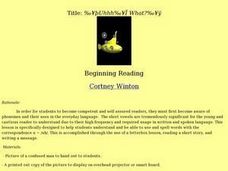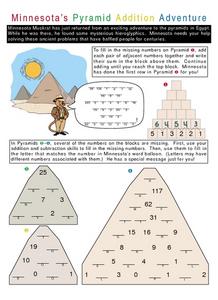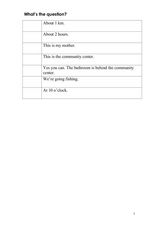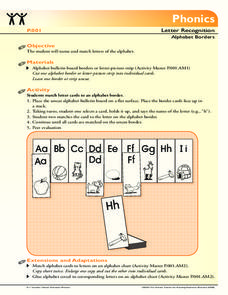Curated OER
ESL: School Subjects
In this ESL worksheet, students unscramble words naming school subject and label their corresponding pictures, fill in blanks about the school day using a given chart and complete true/false questions.
Curated OER
Thirteen Moons Language Lesson
First graders study, discuss, and memorize the meanings in the Oneida Language of the most commonly used names for each of the Thirteen Moon cycles in their community. They draw pictures corresponding with the name of each of the moon...
Curated OER
Say Ahh Went the Doc
Students recognize the short vowel O in written and spoken language. Through matching activities, they discriminate the short vowel /o/ from other vowel sounds. Students associate the phoneme with its letter representation and identify...
Curated OER
Uhhh..What?
Students identify and become competent and in reading the letter u, pronounced /uh/. They also use and spell words with the correspondance u = /uh/ by the use of a letterbox instructional activity, reading a short story, and writing a...
Curated OER
Writing Practice
In this literacy worksheet, students practice looking for the spaces needed to complete each word and then draw a line to the corresponding picture.
Curated OER
Minnesota's Pyramid Addition Adventure
In this addition game activity, students help Minnesota Muskrat solving the addition pyramid problems by adding the adjacent pairs of numbers and write the sums in the blocks above them. Students solve the second set of pyramids by using...
Curated OER
Shhhhelly Shhhhrimp
Students read and spell words via alphabetic insight that letters stand for phonemes and spelling. They map out the phonemes in spoken words. This instructional activity will help students identify the letters s and h, along with the...
Curated OER
ESL: What's The Question?
In this ESL questions activity, students make up questions for a set of 7 answers, fill in blanks to complete sentences and check the box that corresponds with actions in pictures.
Curated OER
School-Home Links: Say Sounds of Letters in a Word
For this letter sounds worksheet, learners look at each word, point to each letter, and make that letter's sound. Students repeat each word on the page. Learners then sound out the letters in their name.
Curated OER
School-Home Links 52
In this letter sounds worksheet, students listen to a family member say each word to their child with short pauses between the letters. The student then repeats the letter sounds back. Both adult and student repeat the process again.
Curated OER
Icky Sticky
First graders the /i/ sound by practicing the way the mouth moves while making the sound while saying "icky, sticky." They write the letter "i" using both upper and lower case letters, make words using letterboxes, and write about a...
Curated OER
IzzyWizzy
Students complete a variety of activities related to the short /i/ sound. As a class they recite a tongue twister, then spell different words using letter manipulatives. Students then read the book "Tin Man Fix It," and identify the...
Curated OER
Learning Phonics Worksheet: Consonants and Vowels 2b
In this alphabet sounds worksheet, 1st graders color all the squares that contain consonants yellow and color all the squares with vowels blue. Once colored, a specific letter can be seen from the color pattern and students write that...
Curated OER
School-Home Links: Sounds in Short Words
In this word sounds worksheet, students point to each word and say it slowly. Family members repeat the word and then ask the children to name the sounds.
Curated OER
Build Fluency /A/
Students are introduced to the letter "A" and play a game to reinforce the printed and sound recognition of the letter "A." In this letter "A" lesson, students observe the teacher model the letter card game. Students participate in...
Curated OER
Introduce /S/
Students determine when the letter s has been pointed out by the teacher and say its sound. For this phonics lesson, students learn the "s" sound and practice saying words beginning with the letter.
Curated OER
Build Fluency /M/
Students determine whether letters shown on cards are "m" or "not m" as the teacher displays each. In this phonics lesson plan, students continue identifying the letter m at as face pace as possible as the teacher moves through the stack...
Florida Center for Reading Research
Phonics: Letter Recognition, Alphabet Borders
Reinforce early reading skills with an activity focusing on letter recognition. Class members work in pairs to match uppercase and lowercase letters of the alphabet.
Curated OER
Indians Are Coming!
Help your class increase their awareness of concepts related to reading and spelling. They identify the digraph /oa/ in spoken language and spelling. After a brief discussion, they read A Toad on the Road, listening for the target sound....
Virginia Department of Education
High School Mathematics Geometry Vocabulary Word Wall Cards
Having a good working knowledge of math vocabulary is especially important for geometry learners. Here are 119 pages worth of wonderfully constructed definitions, constructions, formulas, properties, theorems, and postulates. This is a...
Curated OER
Understanding Proportions and Scale Drawings
Proportions are ratios found using multiplication or division. Middle schoolers solve measurement problems, find a figure's missing dimension, and find the distance between two points. Resource features four lesson plans with detailed...
NASA
Einstein and His Times
Scholars research and present on the historical happenings of 1919. After sharing their findings, pupils debate about how Congress dealt with the moral issues of the time. The evaluation asks learners to write a persuasive...
Curated OER
Atomic Properties of The Elements
In this chemistry worksheet, students examine the periodic table and how it is used in the context of interpreting compounds and their structure.
Curated OER
Shaquille O'Neal Hand & Foot Span
If Shaquille O'Neal wears a size-20 shoe, how big are his hands? Learners will use the average ratios of foot length to hand span to calculate the hand span of Shaq, but first, they have to collect the data! They will...

























